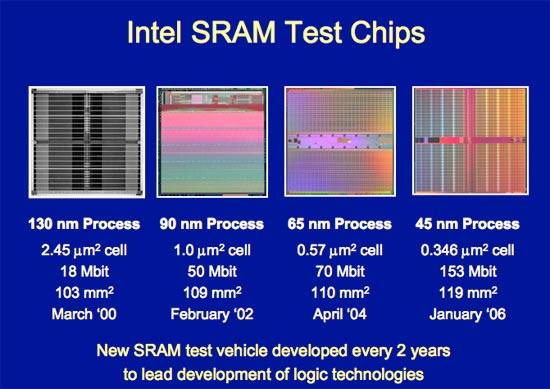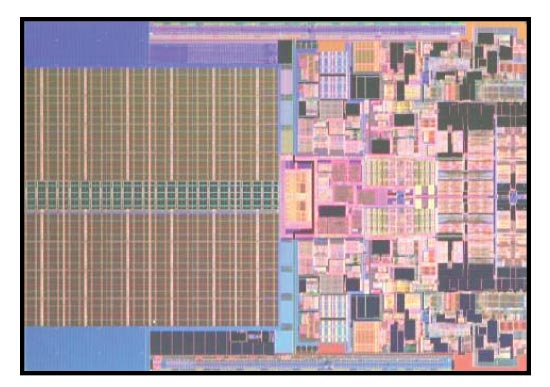Intel Demonstrates new 45nm Transistors and Conroe's Successor
by Anand Lal Shimpi on January 27, 2007 12:00 AM EST- Posted in
- CPUs
Conroe has a Son: Introducing Penryn
Intel announced the first working high-k + metal gate transistors back in 2003. By 2006 it had built an SRAM test vehicle (a wafer full of nothing but cache and some control/test logic) using the new transistors to work out most of the kinks in the manufacturing process.

Today, Intel is announcing that its first full CPU built using the new 45nm high-k + metal gate transistors is not only up and running, but it has also booted four OSes. The very first packaged Penryn silicon from the very first wafer booted Windows Vista, Mac OS X, Windows XP and Linux on the first try.
The picture below is of Intel's validation team after they successfully booted Penryn on the above OSes. The chips arrived in the lab at around 1AM and by 3AM they were up and running. If you're concerned, that's sparkling cider in those glasses and not champagne; alcohol is not allowed on Intel's campus, as it tends not to bring out the best in CPU designs, although it does make benchmark scores look infinitely higher.

It's a fairly big accomplishment to have first silicon working this well, but Intel has had a number of successful first spins in recent history. Generally by the time you're making your first CPUs, you've got the majority of the manufacturing defects worked out thanks to your SRAM test vehicle, so any problems with the first silicon are usually due to errors in the design or in the masks.
Intel also proudly sent us a shot of the 45nm Penryn die:

This version of Penryn is dual-core, and the first quad-core Penryn chips will simply be two of these on a single package, although later on we may see a single-die solution. At 410 million transistors, we expect a dual-core Penryn to have a 6MB shared L2 cache (up from 4MB in Conroe). The logic part of the Penryn core will be mostly evolutionary from Conroe, but do expect additional functionality and performance from more than just a larger cache.
If we assume that 288M transistors (6T SRAM) will be used by the 6MB cache, that leaves 122M transistors for L1 cache and the rest of the core. Applying the same calculation to Conroe gives us 99M transistors left over, meaning that there are roughly 23% more core-logic, control and L1 transistors being used in Penryn than in Conroe.

What that additional functionality will be is up in the air at this point, but you can expect SSE4 support to occupy a chunk of those transistors. At 45nm Intel should also be able to ramp up clock speed, so expect to see Penryn debut at over 3GHz easily. Given how overclockable Conroe turned out to be, we wouldn't be too surprised to see Penryn scale very well.
And the last bit of Penryn information Intel is letting out today is that it demonstrated Penryn up and running actual applications at a press briefing in Santa Clara on January 25th. There were five Penryn systems configured and clocked as follows:
1) 45nm dual core mobile processor in a notebook with Microsoft Vista running Microsoft Office 2003 applications.
2) 45nm dual-core desktop processor running high definition video content (1080P) under Microsoft Vista. 2.13 GHz
3) 45nm quad-core desktop processor running Ubisoft Rainbow Six Las Vegas game under Microsoft Vista. 1.86 GHz
4) Two 45nm dual-core processors running Glaze Workstation application under Microsoft Windows 2000 Advanced Server. 2.13 GHz
5) Two 45nm quad-core processors encoding a video in Adobe Premier under Microsoft Vista. 2.13 GHz
All of the systems were air-cooled using normal heatsink/fan units. Unfortunately Intel wouldn't share any benchmarks or more details of the systems other than what software they were running.
At this stage in the game it's normal to see clock speeds much lower than final shipping silicon, but this is the first time that Intel has been so forthcoming with clock speed data this far before launch. What we're seeing is a far more proud and confident Intel, and honestly it has every reason to be given the recent successes of Core 2 and promise of Penryn.










59 Comments
View All Comments
Pythias - Saturday, January 27, 2007 - link
Thats good. We don't want anyone in this race "doomed".stmok - Saturday, January 27, 2007 - link
Agreed. We don't want to return to the era of a "one horse race" and prices are high!They must challenge each other and as the end-users, we cheer for falling of prices! :)
cornfedone - Saturday, January 27, 2007 - link
When you've been getting your butt kicked for over two years by AMD and your response is to add cache to inferior CPU designs, everyone pretty much knows you're desperate for good press. Intel's 65nano hype is being closely followed by their 45 nano hype as the never ending Intel PR machine marches on. Intel knows full well that Barcelona will trump Clovertown so they are trying to convice the naive that Intel is the future and not to be swayed by AMD's superior CPU architecture ready to break cover. When all the hype is said and done you can expect AMD to be doing just fine thank you and still providing leading edge CPUs for the masses.verndewd - Sunday, January 28, 2007 - link
the walk is the walk,Intel is dominating the perf turf.We all like to see equality in competition,but sometimes its not accessible.K8 had a great run,and it was an eyeopener for intel.At the same time i think its awesome to see intel flex their intelligence and dominate so decisively.I am an am2 user,I just love how this perf war is turning the tech world into an incredible battle of intelligence.Bonesdad - Saturday, January 27, 2007 - link
Cramitpal? Is that you?shabby - Saturday, January 27, 2007 - link
Can you post some barcelona benchmarks? Thanks.stmok - Saturday, January 27, 2007 - link
cornfedone is the same weirdo that talks about putting hackers in jail when it comes to breaking DRM!Seriously, you have to be pretty passionate about AMD to say something like this.
I personally don't care of brand. I flip-flop to any brand, as long as they meet my requirements on specifc roles.
I usually I wait until Anandtech and TechReport starts publishing benchmarks before forming an opinion. (Although I wish they did more Linux articles!)
bamacre - Saturday, January 27, 2007 - link
LOL, looks like some hasn't sold their AMD stock and moved their money into Intel. Better hurry. :DViditor - Saturday, January 27, 2007 - link
I think selling AMD to buy Intel is a really bad idea...as is the opposite.
Neither stock is going to go up for awhile, and they're both going to do the same as long as the price war continues...
bamacre - Saturday, January 27, 2007 - link
I disagree. I predict Intel's stock to climb 80% in 12 months. Assuming no terrorist attacks, invasion of Iran. If somone nukes Nigeria, however, that number will be closer to 125%.